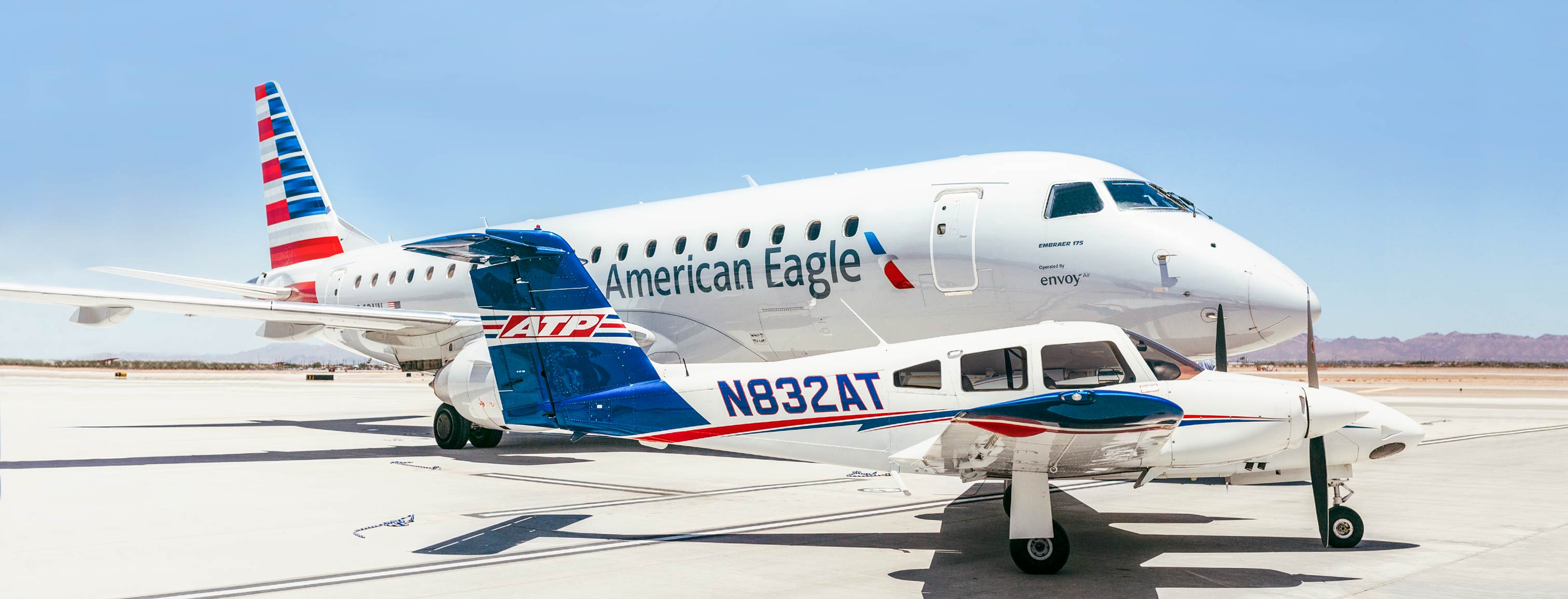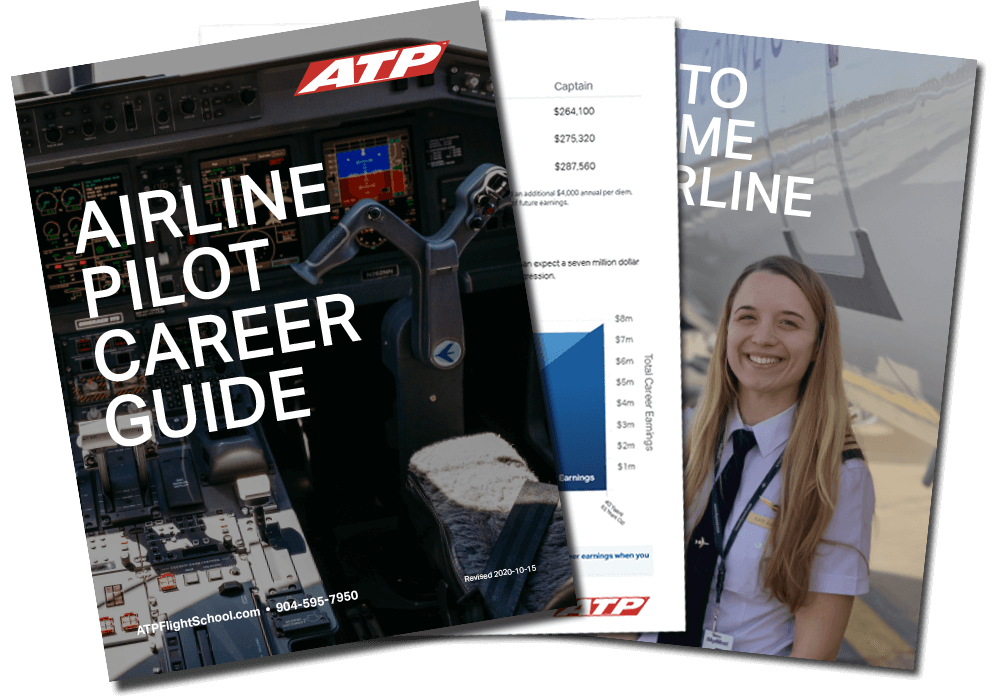Watching talented individuals give life to their dreams and successfully pursue them is a very rewarding experience. It is especially so if you are lucky enough to watch an aspiring airline pilot go from a new student to the cockpit of a modern airliner. It takes a determined effort to succeed, but the rewards of succeeding in this venture are better than almost anything else you can do.

Eric Bottomley is presently a First Officer for American Eagle Airlines and I had a chance to talk with him on a recent break from flying:
Hi Eric, how early in your life did you begin to become interested in being an airline pilot?
Hi Paul. I’ve always wanted to be a pilot. I just wasn't sure if I wanted to do it as a career or what avenue I wanted to take to get there. After attending college and moving all around the country and holding a lot of different kinds of jobs, I had accumulated a long list of careers that I had no interest in and a very short list of dream careers. I found myself living in the suburbs of Chicago and working for a major airline "throwing bags" on the ramp crew. This job came with the wonderful perk of flight benefits! I found myself on the majority of my days off hopping flights all over the place to visit friends, or just to explore other parts of the country. I have a distinct memory of sitting back in cruise flight late one night thinking to myself, 'I really like this, why am I not doing this again?'
I did have the luxury of seeing what being an airline pilot really is like through my father, who was a pilot for the United States Air Force and has since moved on to flying for a major carrier. This gave me a realistic view of the good and bad things that come with the job. As far as my priorities and what I want from my work and my life, the life of an airline pilot is exactly what I wanted.
How did you arrive at the final decision to pursue aviation as a career?
There were a few factors I considered when it came to choosing my path for pilot training. The first decision, a big one, was whether to go the civilian or military route. For me, I knew if I wasn't going to be the one flying the airplane I didn't want to work around them. There is no guarantee of being granted a pilot slot in the military, and also there is an increase in unmanned aircraft usage there. The chance of being able to strap metal on and go fly wasn't that great. Therefore, I was willing to invest money in my pursuit and go the civilian route.
How did you decide where to go for your flight training?
I knew I could handle a fast paced training program, and I really wasn't interested in a part time or a four year track to my goal. I knew that ATP could get me where I wanted to be in a minimal amount of time, with maximum exposure to valuable multi-engine experience, and real world flying. Basically, I was serious and so was ATP so that’s where I went.
After you completed training what did you decide to do?
After completing training I was torn between taking a breather, getting a job in a more relaxed paced environment or putting in a resume with ATP for a flight instructor position. After graduating from the career pilot program I knew I had the minimum multi-engine time in my logbook to get a First Officer position at the majority of the regional airlines out there. I just needed more Total Time, which would give me flexibility in looking for an employer. But something inside kept telling me that I really should stick around and teach at the school where I learned to fly. So I had one of my former instructors walk my resume in and came on board as an instructor at ATP. I really enjoyed teaching pilots that were full time students of aviation and hungry to learn at a professional level.
With all of that Flight Experience, what made you decide to take the Regional Jet Standards Certification Program at ATP?
I was instructing for ATP when the industry was in a slump and furloughs were happening at nearly every airline with stagnation at all levels. I had become quite proficient at my job and really needed a new challenge in aviation. No one was looking for new jet pilots, but I wanted to get a taste for what I was in for once the industry picked back up and to see how it compared to what I was currently doing in aviation so I could pass on some little things to my students along the way. I knew the regional jet course could give me the exposure you can’t learn from a book, and a little something extra I could include in my resume.
Can you offer some tips for pilots trying to get their first job with an airline?
Getting the first airline job... No matter how prepared you are, you never feel prepared enough! To put it simply, know your stuff (Instrument Flight Rules, Jepps Charts, systems of the airplane that you currently fly), have your paperwork neat and in order with 2 color copies of everything, know a little about the company you are applying to (have questions for them) and most importantly show up with a great attitude. They want guys and gals that WANT to be there, and a lot of the people involved in the hiring are Captains at the airline. These Captains want to see someone on the other side of the table that they could stand flying a four day trip with.
The first day of the interview consists of a typical human resources portion; a basic simulator evaluation and a technical portion (know your Jepps Charts!). If you make it through day one they set you up in a hotel for a basic medical evaluation the next morning and then give you a conditional job offer letter. After you head home your paperwork is sent to a Captain's Review Board where the final yea or nay decision is made. Weeks, or possibly months, later you get the phone call that you are hired and the rest is history.
What was your Initial New Hire Training like?
New hire training is great! The Weeding-out process is completed at the interview, so now your airline is investing in you and they want you to make it through training. New hire training, or "long term" for me, lasted approximately 5 weeks. Week one consisted of basic indoctrination where you learn the company rules, operations and security training… that sort of thing. Nothing airplane specific is discussed there, it is all about company policy. Weeks two and three were aircraft specific ground school, which included in depth systems training, FMS training and practicing cockpit flows. Once that was complete there was a final written exam followed by the oral portion of your check ride. Once the oral exam was passed, we started 9 days of simulator training. We were in the Sim about 4 hours a day, 2 hours as the pilot flying, 2 hours as the pilot monitoring. Then finally the simulator check ride. If you put in hard work studying, training is very manageable.
How was your experience during Initial Operating Experience (IOE)?
IOE was interesting. After so many hours working as a flight instructor I found myself observing what I was doing through my IOE Instructor's eyes. I could hear myself thinking “Eric, why are you doing that?” I was my own worst critic and it was very distracting. Once I let that go and just flew the plane everything went much more smoothly.
How is it going now that you are flying the line at American Eagle?
Flying out on the line has been great. I am really enjoying all the freedom that comes with the job and the variety of flying in so many different regions around the US, Canada and Mexico.
My probationary check ride is coming up, the last big hurdle before getting off probation. So, it's time to get the books back out and refresh for another check ride.

